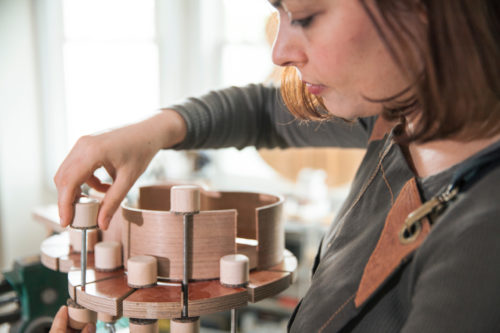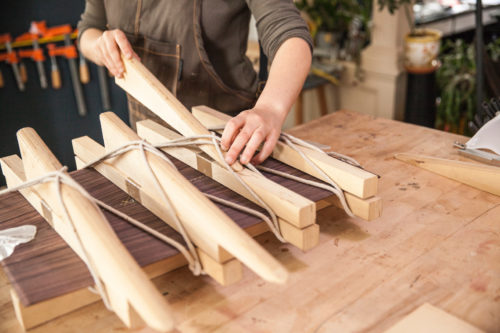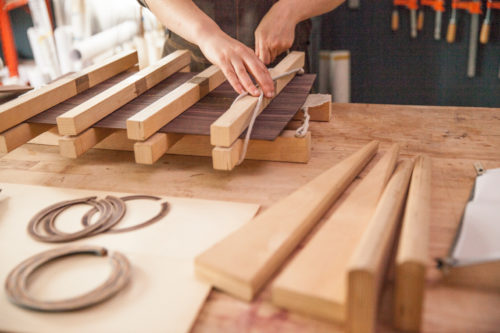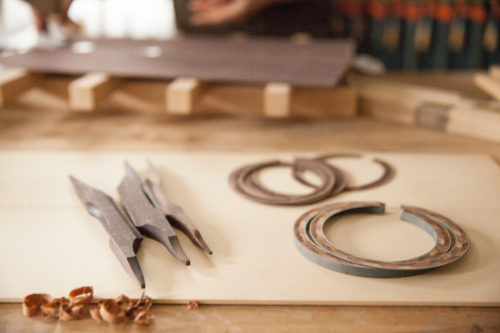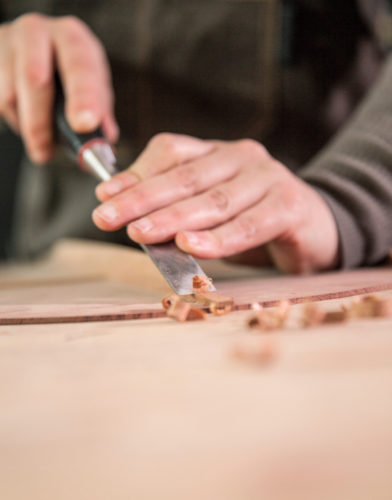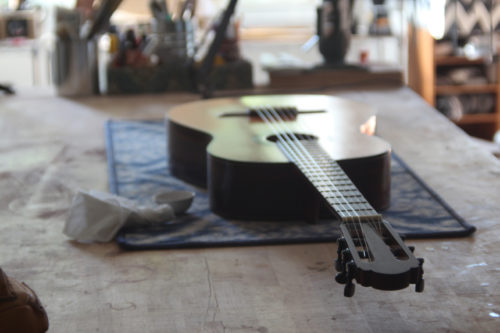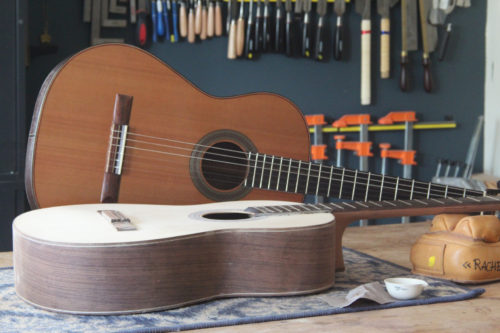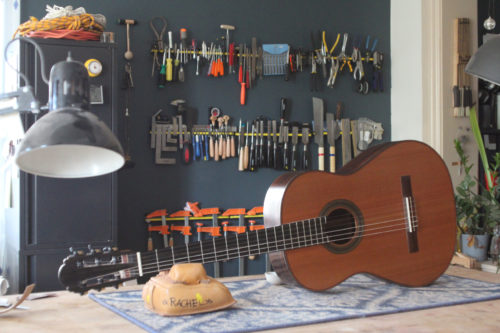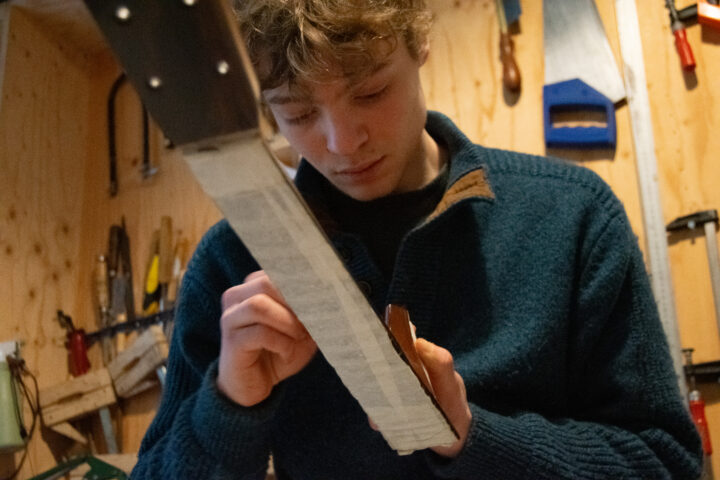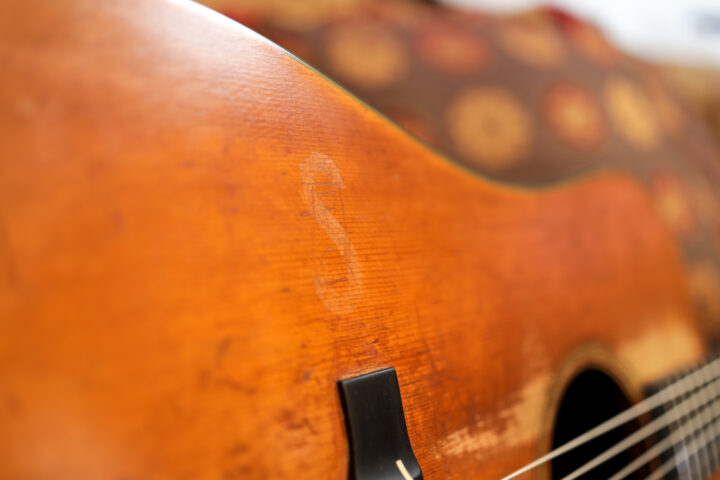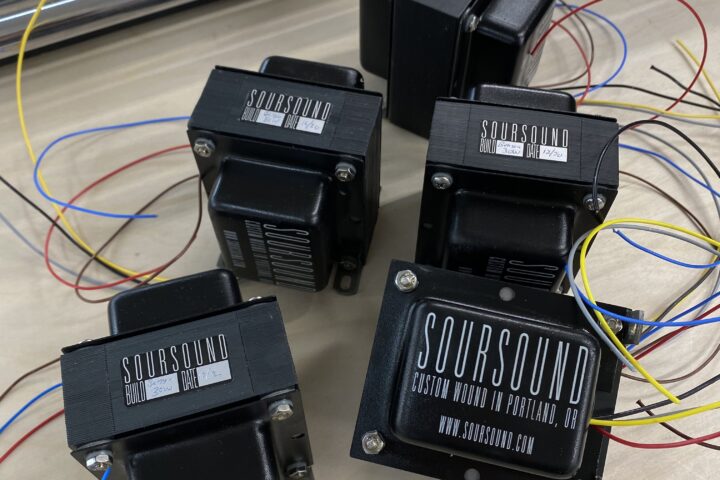We find folks for our Bench Press column all kinds of ways – reputation, referrals, Instagram… and sometimes they appear, as if by magic, in our subscriber database. That’s how we found Rachel Rosenkrantz of Atelier Rosenkrantz. Rachel is a French builder, now based in Providence, Rhode Island, who has produced some notably eye-catching instruments, not just guitars but ukuleles, charangos and more. So we reached out, and, lucky for us, she agreed to be subjected to the Bench Press treatment…
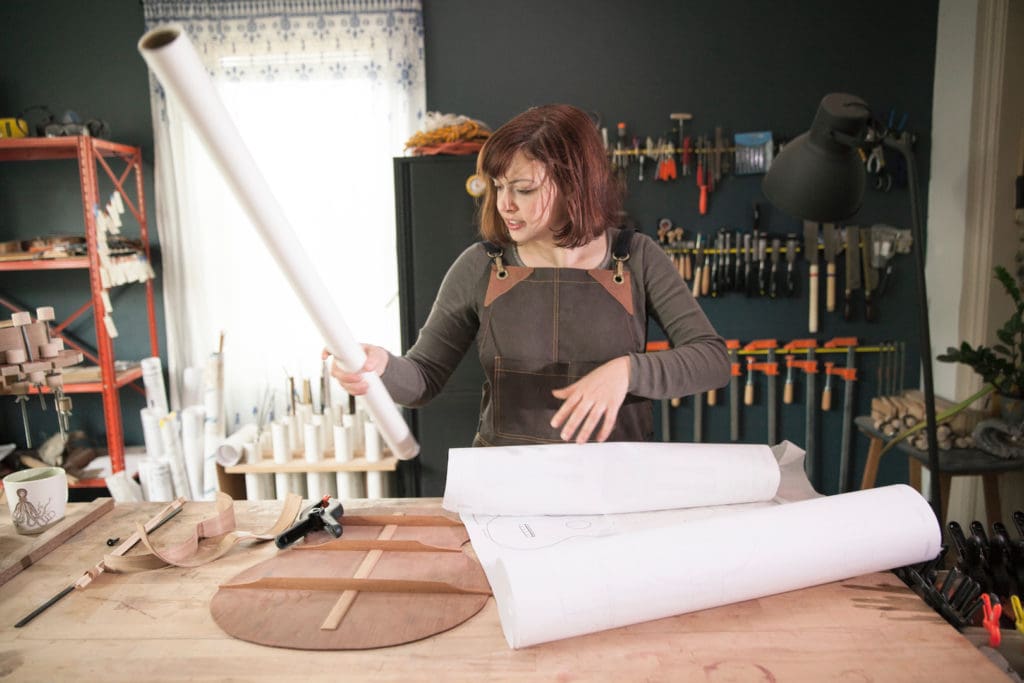
Fretboard Journal: What’s on your bench right now?
Rachel Rosenkrantz: Currently I have a gypsy jazz guitar on my go-bar-deck, a contemporary charango on my drafting table, I am half-way through the carving of a modern violin on my main workbench and French-polishing a mezzo-soprano ukulele on my secondary bench. I have a small box on my desk where there are piles of strange tiny metal objects for inlays on a yet-to-be-made humidor-guitar. That’s for a current one-of-a-kind/made-to-order commissioned work. I just finished the neck shaping of four classical Hauser-style guitars destined for retail. And on my machine-room bench I am improving the design of the jigs of my Shaker-parlor guitars – the design is based on the Shaker’s craft philosophy. And always current but on-site because it is too big for my bench, the maintenance of the Bosch Hurdy Gurdy, a 12′-long hurdy-gurdy designed and built based on the Hieronymus Bosch’s triptych Garden of Earthly Delights. The panel representing Hell depicts giant instruments including a boat-sized hurdy-gurdy and this one sounds as ferocious as the end of the world! The Rhode Island-based music composer Steven Jobe came up with this wild idea 10 years ago and made it happen for one of his operas, the instrument is now 10 years old and keeps improving all the time. The more it is performed the more ideas are generated to make it sound better. I love how it is organically growing into what it needs to become. Last, but not least, and leaving my workbench this week, the Passerelle, a guitar accessory I collaborated on with Kaki King, which is going to be released this summer.
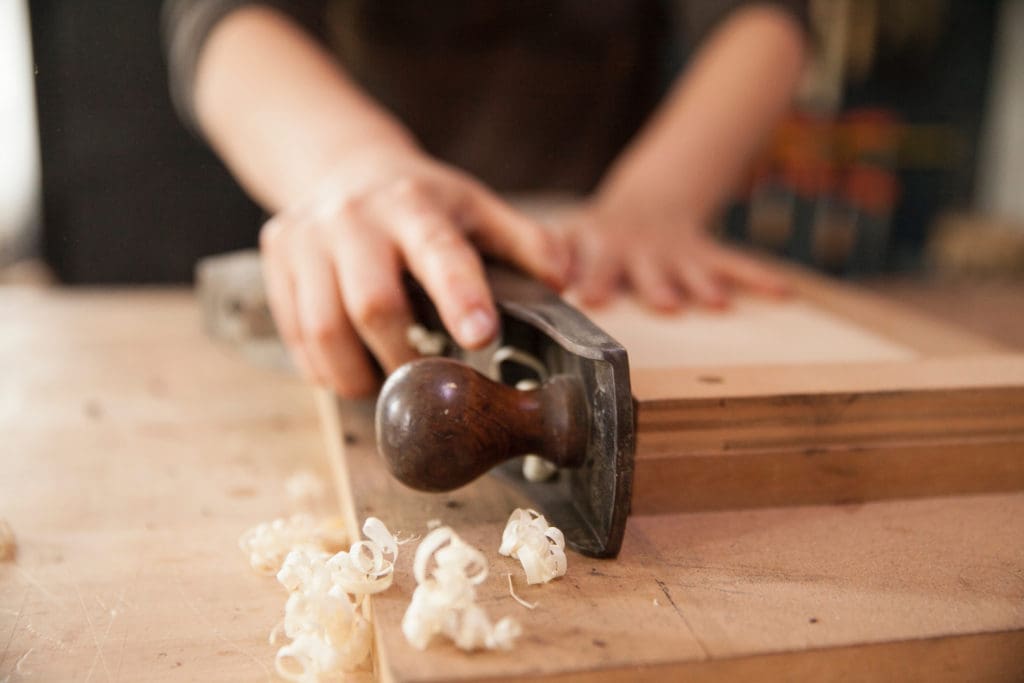
FJ: Can you tell us about your shop?
RR: I shared shops for years. It takes time and money to acquire machinery. I now have had my own woodshop for exactly one year. I am located on the West Side of Providence in a very up-and-coming neighborhood. I am surrounded by other new small businesses, which creates a contagious sense of enthusiasm and energy. Many amazing musicians live on this side of town. It is quite perfect. I had the tremendous opportunity during the recent past to share a shop with Otto D’Ambrosio, with whom I learned all the steps of lacquering. I also shared space with Zachary Martin, with whom I witnessed the meticulous skill necessary to work on museum grade or ancient instruments.
Watching them work definitely set a standard for me. My shop is a small yet efficient 400 square feet. My bench is wide and right in the middle of the space. Everything else gravitates around it and is reachable in just a few steps. I maximized my wall space: Hand tools on the closest wall, wood storage on opposite wall, guitars displayed on the rear wall and amazing light exposure with seven windows. This creates the perfect environment in which to work as it casts sharp shadows allowing me to easily read shape and making it very easy to spot a bump, a scratch or dust on finish.
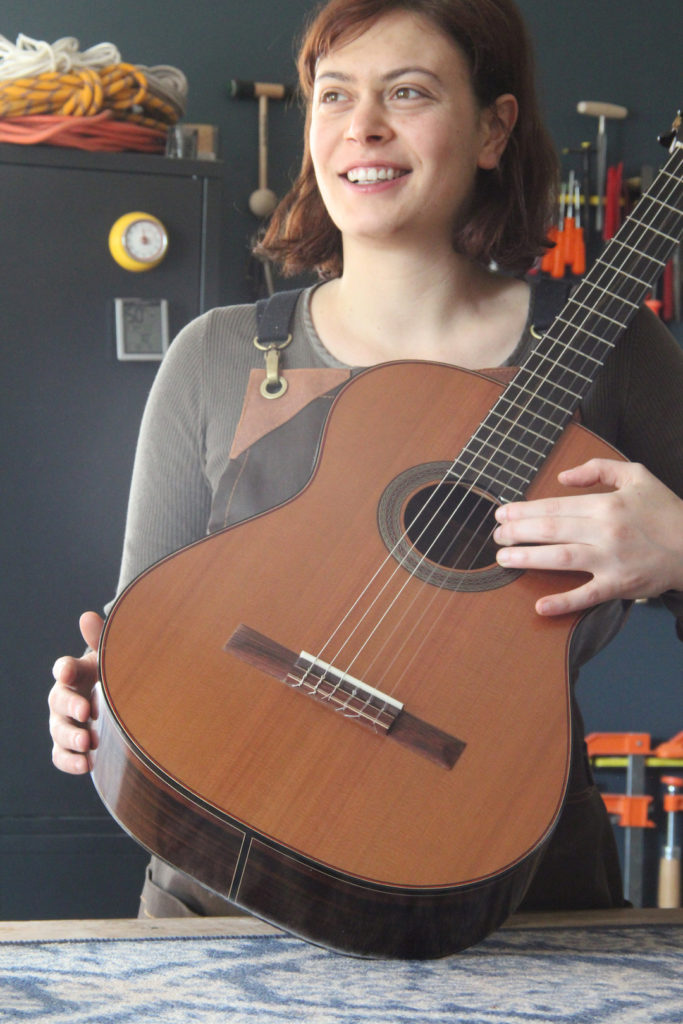
Photo Credit: Rachel Rosenkrantz
FJ: Do you have a particular philosophy about wood/materials?
RR: Let’s face it, ebony has been exploited through the roof for way too long and we all know it, we have to find alternatives, at this point it becomes a moral issue. The use of sinker redwood is disturbing swamp creatures in their ecosystem, which we have started to be aware of now. I can list a lot of similar examples. We could have a whole conversation on rosewood alone! We have to be inventive and resourceful and start questioning the assumptions. There are so many options out there and even more yet to be explored. We have to stop being hung up on how things are “supposed-to-be.” We must expand the envelope and innovate in our field. I believe my design background has to do a lot with that approach. I worked for years on innovation teams exploring sustainable technologies, I can’t help it, for me its just second nature, a woodshop should also be a lab. There is only one-way to find out if an idea will work or not. You must do it. And should you realize you didn’t do it first, then do it better! I get bored quickly to be honest and finding the equilibrium between form and function always keeps things challenging.
FJ: How did you get started?
Seventeen years ago in Paris while attending l’Ecole Supérieure d’Arts Graphiques Penninghen, I happened to live two blocks away from the Ateliers Maurice Dupont on avenue Daumesnil (their operation is in Cognac). I walked by their shop everyday on my way to school. I was a furniture and industrial design major at the time and was fascinated by what I saw, especially since I have been playing classical guitar since I was a child. This resonated a lot with me and definitely planted the seed in my head. Then school was very demanding and I didn’t have time to play music much and forgot about the idea. I went full-fledge into a design career where I dealt with a lot of woodworking and innovative designs in multidisciplinary design firms. I started playing music again. Naturally the idea of building guitars came right back to me as this discipline combines all my passions. It was a very natural progression. I was fortunate to find Dan Collins, a luthier in the South County of Rhode Island, from whom I got old school training, which focused on acoustic guitars. I was daydreaming about this for too long to not do it. I quit my day job to embrace guitar making fully.
FJ: You build more than just guitars. What drew you to building some of these more unusual instruments?
RR: I was the kid that took apart her toys to see how things work. It really is all about curiosity. Stringed instruments share common principles in the way they function; yet all instruments sound so different. I am attracted to the convergence and divergence of architecture in this field. What makes a bouzouki sounds so different from a guitar when they both have similar neck length and wood species? Why does a balalaika sound so busy with only three strings and a minuscule sound hole? Why can a sitar project so much with such a small body? Playing other instruments on a regular basis also contribute to this curiosity as I am exposed to more than guitars. And let’s face it: If you can build a good guitar, you’ll most likely have no problem building a ukulele, a guitar-bass or an Irish-style bouzouki… I will not dare venturing in wind instrument for even a hot minute!
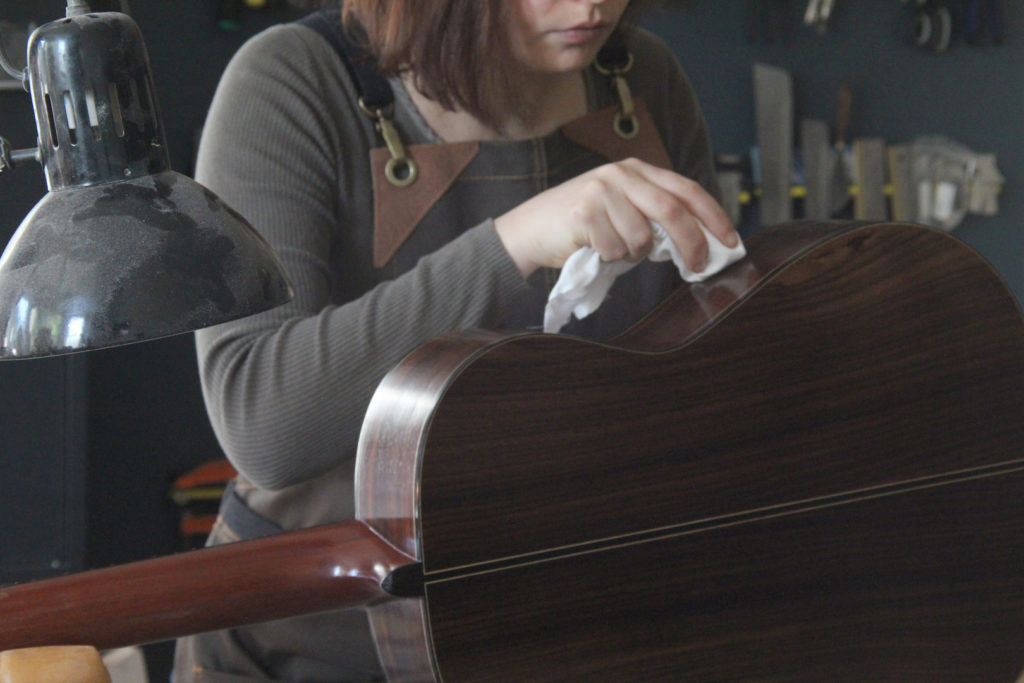
Photo Credit: Rachel Rosenkrantz
FJ: Where do you draw the line between “repair” work and “restoration” work?
RR: I learn from restoration, not necessarily from repair. Restoration requires some reverse-engineering to fix the instrument the way it would have been in the area it was made, which involves research and educated guesses. What is interesting too with old instruments that have been fixed a couple of times over a century is to see other luthier’s approach as you dig in. There’s always more than one solution to solve the same problem. I’ve learned the most from mandolin restorations, especially on neck reinforcement.
FJ: Are there any upcoming projects that you’re particularly excited about?
RR: Chronologically, I have three imminent things I am excited about (chronologically, just to be fair, as I am equally excited about those three things).
First, I am excited about the work my students are doing at the Rhode Island School of Design. I teach Spatial Dynamics within the Division of Experimental and Foundation Studies. The students invented and are handcrafting acoustic instruments. The class will culminate with a performance. Many of these students are being exposed to woodworking for the first time and most of them are not musicians. They are way outside of their comfort zones. However, as they have no preconceived notions of lutherie or its limitations they are able to arrive at unconventional yet splendid design solutions. This is a wonderful “umbrella” assignment as it includes drawing, ergonomics, joinery, etc… a true “form and function” embodiment exercise. The students will perform a small piece they are currently writing to showcase what their instruments can do. A Q&A regarding the design process of their work will follow the performance. I am really proud of them fearlessly thinking outside the box.
The second exciting thing is the release this summer of a guitar accessory I developed with Kaki King. We both worked on it last winter and we just finished the demo video. We now have a bunch in stock. Stay tuned, as this will completely modify your guitar in a non-invasive way!
I am also very thrilled that my guitars are soon going to be in stores in Europe (in Copenhagen, in the wonderful Christiania district, which is also known for handcrafting one of the best bicycle designs in the world).
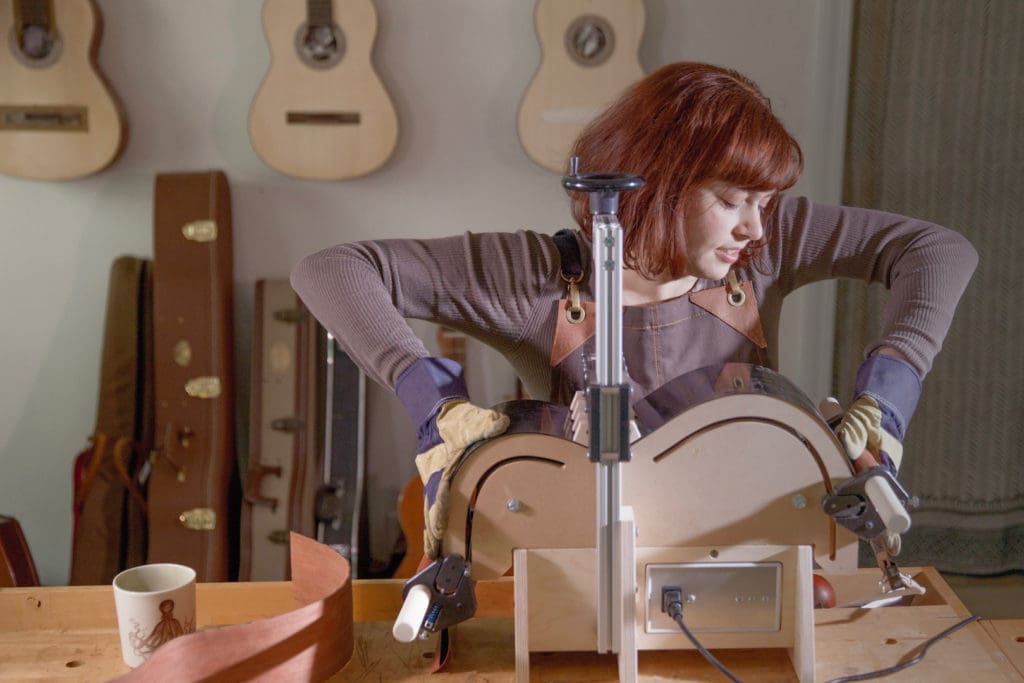
FJ: Do you have a favorite guitar that has crossed your bench?
RR: A 1916-ish Stella parlor that I restored last summer. It was nothing fancy nor too ornate, yet very elegant and simple and in possession of a striking sound projection. Considering how small its body is, you can tell that its design had been optimized as soon as you hear it. A returning costumer rescued it from her sister’s trash after clearing their basement. I am glad she did. It was aging on schedule: soundboard was cupping from the bridge pressure of the strings resting on it under tension, the tailpiece rusted, some frets buzzed and a terrible 1980’s offensive plastic homemade refinish needed to be corrected. That instrument had fantastic ergonomics on the neck, making the playing very comfortable. I could play this guitar for hours. A guitar like this would be perfect for long gigs or music writing. The materials were also a good quality; the mahogany had barely budged considering it wasn’t stored properly for decades.
I ended up doing a simple open pores finish with oil. The wood is nice on its own and it ends up sounding so much better—more open and complements the simple honest aesthetic of the guitar. My costumer’s brother is now actively playing it, that’s one of the beauties of our craft, not only do we build life-companions for musicians but give a second life to those instruments that outlive there original owners. One guitar can have so many lives.
Photographs by Kia Davis, except where noted.
